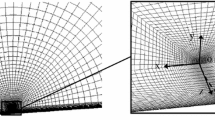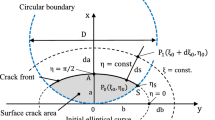Abstract
This paper analyses the influence of the discretisation of the crack front on the fatigue propagation prediction of semi-elliptical surface cracks. A simple method based on closed-form solutions for the stress intensity factor is used to discuss the effect of the discretisation. It is concluded that the analysis based on just two points along the crack front is sufficient to predict crack shape and fatigue life.
Similar content being viewed by others
Reference
Bressers, J., Martíinez-Esnaola, J.M., Martin-Meizoso, A., Timm, J. and Arana, M. (1996). Coating effects on crack growth in a single crystal nickel based alloy during thermomechanical fatigue. Thermomemechanical Fatigue Behavior of Materials: Second Volume, ASTM STP 1263 (Edited by M.J. Verrilli and M.G. Castelli), American Society for Testing and Materials, Philadelphia, 82–95.
Cruse, T.A., Meyers, G.J. and Wilson, R.B. (1977). Fatigue growth of surface cracks. Flow Growth and Fracture, ASTM STP 631, American Society for Testing and Materials, Philadelphia, 174–189.
Hosseini, A. and Mahmoud, M.A. (1985). Evaluation of stress intensity factor and fatigue growth of surface cracks in tension plates, Engineering Fracture Mechanics 22, 957–974.
Martinez-Esnaola, J.M., Arana, M., Bressers, J., Timm, J., Martin-Meizoso, A., Bennett, A. and Affeldt, E.E. (1996). Crack initiation in an aluminide coated single crystal during thermomechanical fatigue. Thermomechanical Fatigue Behavior of Materials: Second Volume, ASTM STP 1263 (Edited by M.J. Verrilli and M.G. Castelli), American Society for Testing and Materials, Philadelphia, 68–81.
Newman, J.C. and Raju, I.S. (1981). An empirical stress-intensity factor equation for the surface crack. Engineering Fracture Mechanics 15, 185–192.
Newman, J.R. and Raju, I.S. (1986). Stress-intensity factor equations for cracks in three-dimensional finite bodies subjected to tension and bending loads. Computational Methods in the Mechanics of Fracture (Edited by S.N. Atluri), Elsevier Science Publishers, 311–334.
Author information
Authors and Affiliations
Rights and permissions
About this article
Cite this article
Martínez-Esnaola, J., Martín-Meizoso, A. Modelling Fatigue Propagation of Surface Cracks. International Journal of Fracture 109, 17–22 (2001). https://doi.org/10.1023/A:1012243608468
Issue Date:
DOI: https://doi.org/10.1023/A:1012243608468




